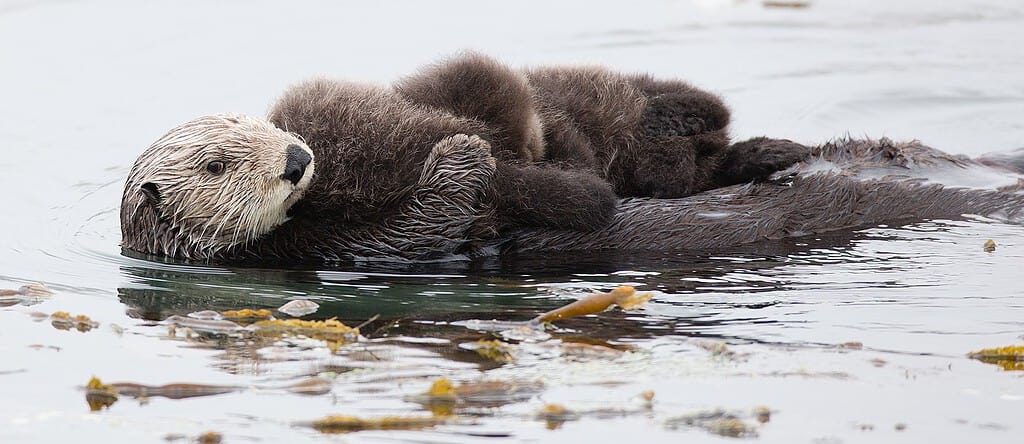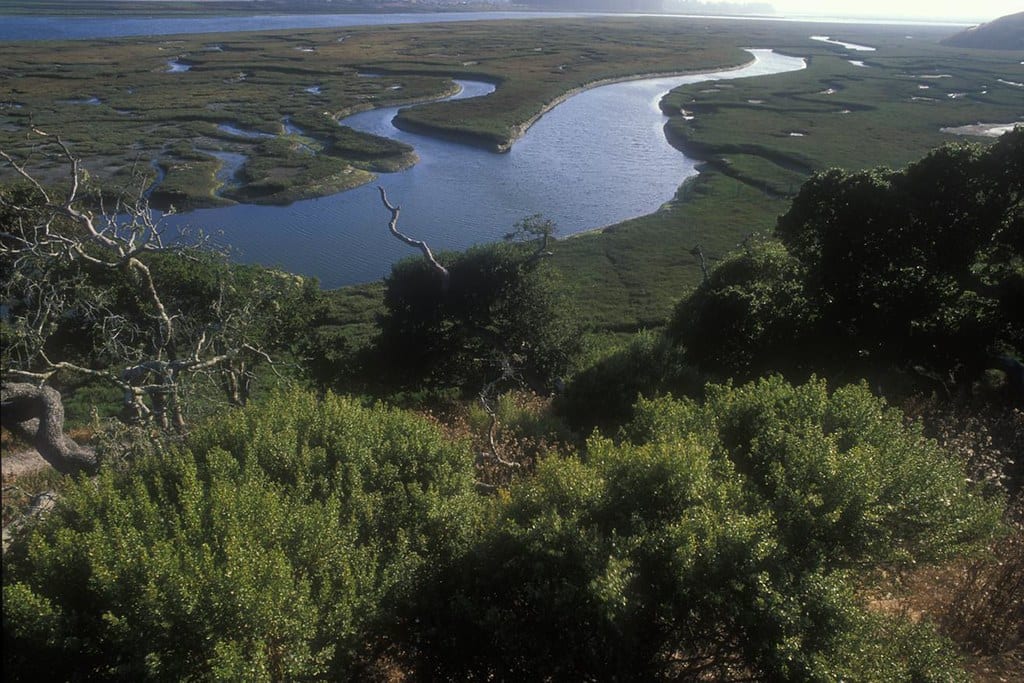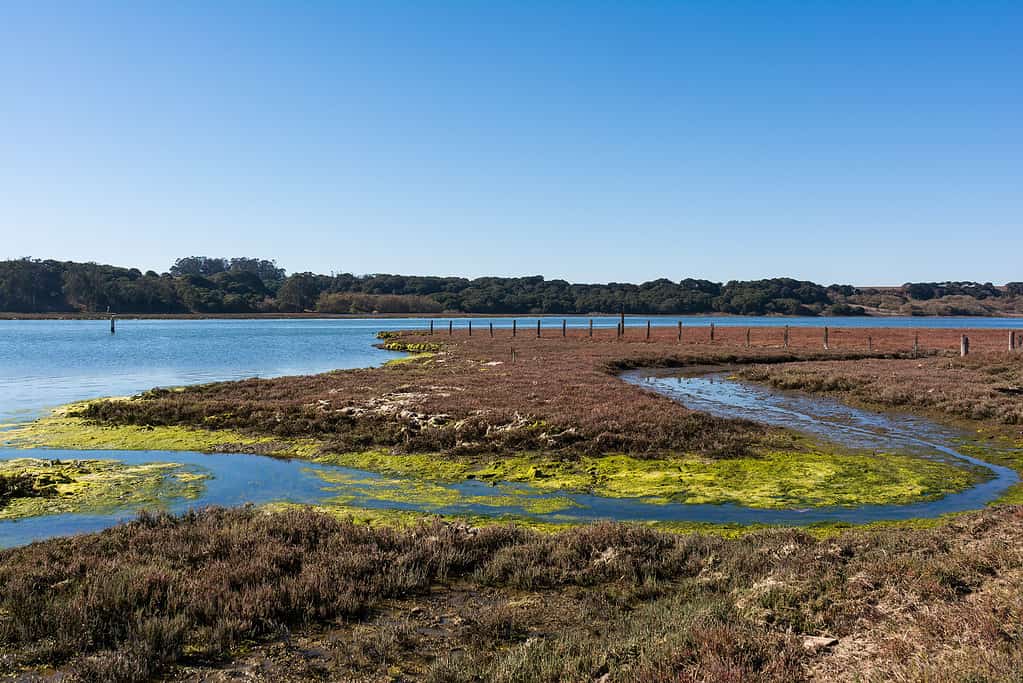
Coastal wetlands, the fertile buffers between land and sea, play a pivotal role in global ecological balance. These areas are not only rich in biodiversity but also provide critical services such as carbon sequestration, flood protection, and water purification. But they too are vulnerable.
Because these ecosystems depend on the interplay between water, soil, and animals, every time something goes out of balance, it can cascade down the entire ecosystem. That’s what happened when humans came into Elkhorn Slough, a salt marsh-dominated coastal estuary in central California.
First, humans hunted the otters for fur. They wiped out most of the otter population. Then, agriculture and industrialization finished driving out the otters completely. With otters being the apex predators, this changed the dynamics of the entire ecosystem. Crabs — one of the otters’ favorite meals — started multiplying like crazy. The crabs started devouring marsh roots that were keeping bank erosion in check. Slowly but surely, this process started accelerating erosion.
Then, the otters came back in.
Otters in charge

With rising sea levels and stronger tidal currents, erosion is on the rise in many parts of the world — especially parts that have been destabilized by human activity.
“Crabs eat salt marsh roots, dig into salt marsh soil, and over time can cause a salt marsh to erode and collapse. This had been happening at Elkhorn Slough for decades until sea otters recolonized the estuary in the mid-1980s,” said the new study’s lead author Brent Hughes, associate professor of biology at Sonoma State University and a former postdoctoral scholar in Silliman’s lab at Duke.
Sea otters, once near extinction due to the fur trade, have made a remarkable comeback in some regions, offering scientists a unique opportunity to study their ecological impact.
“After a few decades, in areas the sea otters had recolonized, salt marshes and creekbanks were becoming more stable again, despite rising sea levels, increased water flow from inland sources, and greater pollution,” Hughes said.
As apex predators, sea otters have a profound impact on the structure and function of nearshore ecosystems. Their diet primarily consists of sea urchins, which, in the absence of otters, can overgraze kelp forests and lead to their decline. The presence of sea otters, therefore, maintains the balance within these underwater forests, which are crucial for carbon storage and as habitats for a multitude of species.
Scientists have previously shown the positive impact that otters have on kelp forests. The new study extends this understanding to coastal wetlands, demonstrating how sea otters’ predation habits influence more than just kelp forests.
To find out how sea otters affect the environment, researchers studied 13 tidal creeks and conducted experiments at five sites in an estuary for almost ten years. They let sea otters return to some areas but kept them away from others. By comparing these places, using both on-the-ground checks and aerial photos, they discovered that where otters lived, erosion decreased significantly— by as much as 80% to 90%— and some marsh areas even started to regrow. Computer simulations showed similar results.
A buffet that works wonders

Otters need to eat a lot of food to stay warm in the cold water; on frigid days, they need to consume up to 25% of their body weight. So you’d expect the environmental impact to be visible pretty fast — and indeed, it was.
By preying on burrowing crabs, which feed on cordgrass, sea otters indirectly protect this vital plant from overgrazing. Cordgrass is essential for coastal wetlands, contributing significantly to their biomass and acting as a natural barrier against erosion. The study’s findings indicate that areas with a healthy sea otter population witness stronger, more resilient marsh edges, less susceptible to erosion and degradation.
“It would cost millions of dollars for humans to rebuild these creekbanks and restore these marshes,” said Brian Silliman, Rachel Carson Distinguished Professor of Marine Conservation Biology at Duke University’s Nicholas School of the Environment, and Director of Duke RESTORE and Duke Wetland and Coasts Center. “The sea otters are stabilizing them for free in exchange for an all-you-can-eat crab feast.”
A new tool in our kit
Of course, it’s easier to prevent than to treat a problem. The otters are here now and they can prevent most of the subsequent environmental damage — but they can’t reverse what’s already been done.
“The return of the sea otters didn’t reverse the losses, but it did slow them to a point that these systems could restabilize despite all the other pressures they are subject to,” Hughes said. “That suggests this could be a very effective and affordable new tool for our conservation toolkit.”
Even so, this is a remarkable finding that could have profound implications not just in California. The implications of these findings are profound, suggesting that the reintroduction and protection of apex predators like sea otters could be a key strategy in combating coastal wetland erosion and loss.
As climate change accelerates sea-level rise and increases storm intensity, the preservation of coastal wetlands becomes increasingly critical. The study provides compelling evidence that conserving predator populations can have cascading benefits for ecosystem resilience, offering a natural solution to some of the challenges posed by environmental changes.
The study was published in Nature.


